Ricochet is the best place on the internet to discuss the issues of the day, either through commenting on posts or writing your own for our active and dynamic community in a fully moderated environment. In addition, the Ricochet Audio Network offers over 50 original podcasts with new episodes released every day.
 Remembering Heathkit
Remembering Heathkit

What’s Heathkit? Well, the version I knew, and which was the most successful edition, was a company that offered a large variety of electronic and electrical equipment in kit form to the public. That’s a far cry from the original Heath Company, which was founded in 1912, as an aircraft company by Edward Bayard Heath, an early aviation pioneer.
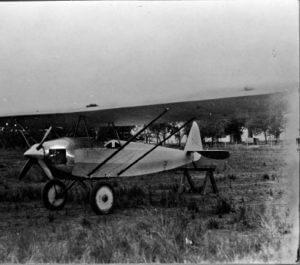
Heath Parasol 1935.
In 1926, Heath began selling a light airplane – the Heath Parasol in kit form. Heath died in a 1931 test flight accident and the company floundered until it went into the electrical kit business in 1947 shortly after World War II. That business thrived for several decades before closing up shop in 1992.
My interest in Heathkit began when I watched my Dad build a Heathkit stereo system. I must have been in junior high school at the time. Prior to that my dad had built me a 5-tube AM radio – the BR-2 which was on my dresser drawer for years. The BR-2 was an early 1950’s design that I believe is regarded as a classic among radio enthusiasts – below are photos of the BR-2 with its cabinet, the BR-2 without its cabinet and the BR-2 schematic.
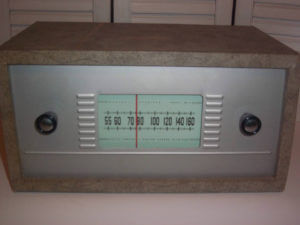
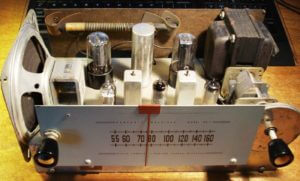
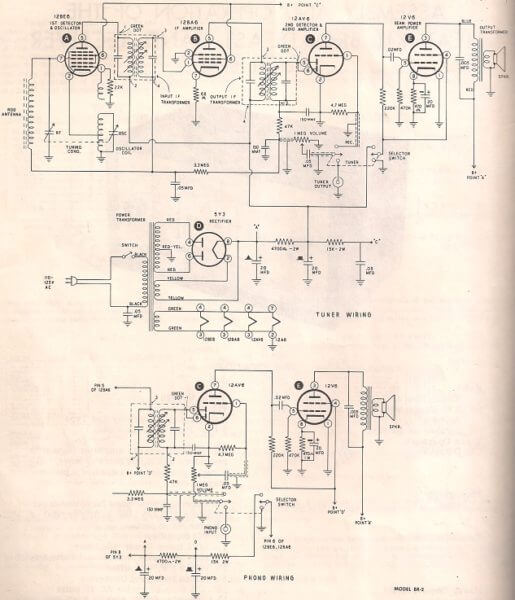
In any event, shortly thereafter I began to buy and build Heathkit products and would continue at it for a decade or so, building radios, receivers, turntables, test meters of all sorts, auto diagnostic equipment and a color television. It was not necessary to know much electrical theory in order to build any Heathkit product; but, it was nigh impossible not gain some knowledge of electricity and electronics in the process of building any kit. All that was required was the ability to read and follow directions, and enough patience and persistence to see a task through to completion. Heathkit would do the rest.
The product was well designed by the Heatkit engineers. Each kit came with a detailed, thorough and easy to read assembly manual. The manual included 1) a complete parts list, 2) sections on safety and proper soldering techniques, 3) color and other codes for resistors, capacitors, etc 4) step by step written assembly procedures with adequate sketches including intermediate and final test procedures with a box to check off each step, 5) schematic(s), 6) a section on the theory of operation for the device, and 7) a troubleshooting section.
Heathkit projects also did not require an overwhelming number of tools. Generally all that was needed were a soldering iron, spool(s) of solder (I think solder came with each kit – it was a warranty issue for Heathkit) , several pliers (needle nose and diagonals being the most useful) wire cutters and trimmers, some test gear (a VOM and ammeter – which Heathkit helpfully offered in kit form) and an assortment of screwdrivers and nutdrivers. One or more muffin or cupcake tins were perfect for sorting parts until they were needed. Oh, and a pencil to check each step along the way.
This New York Times obituary of the company in 1992 does a good job of explaining the legacy of Heathkit and the causes for it’s demise. The continued technological improvements in electronics with integrated circuits (IC) taking the place of various circuits and the accompanying discrete components led the kit-building model towards extinction. It’s just not much fun plugging in a couple of IC’s and there were no longer any labor costs to be saved. Oh, and I didn’t know that Barry Goldwater also caught the Heathkit bug.
I was just one of hundreds of thousands (actually probably millions) to derive pleasure and satisfaction from my Heathkit experience.
Published in General



By the way, some really neat little kits are coming back. Check QST Magazine for ads and reviews.
I built a couple KnightKits, a regenerative receiver and a vacuum tube multimeter. Instructions weren’t the equal of Heath, IIRC, but I never had trouble getting them working.
The sweet smell of roasting phenolics? If it smokes up blue, you’ve let the electrons out and it won’t work!
Well, Paris, you know how to fix that! Heck, you may even get to do it on a Heathkit by visiting a local swapmeet. I’ll be listening for you!
Thanks Paris.
Agree. I think that’s the main cause for the demise of the kit building model.
Good point. There was a distinct smell, wasn’t there?
Hadn’t thought about, but I think I too had a pleasant image of the place. Checking it out on Wikipedia, it sure has seen better days. The city today is bankrupt and has a special master of some sort. And, the city population has fallen from 19K in 1960 to 10k today.
I wonder how many towns put a word like Harbor or Beach into their name just to make it seem nicer or more upscale than it is?
I built a bunch of Heathkits when I was a teenager – great stuff! One was a weather station with a component mounted on the roof and a display in the hall that showed the temperature outside and wind speed and direction.
I recently checked out the old homestead on Google Streetview and was disappointed to see that the current owners had taken it down. Very disappointing.
Good job RushBabe. And just think, that was before International Women’s Day or whatever it’s called!
Hallicrafters had a great line, as I recall available in kit or built form. I believe they had a better reputation than Heath in quality, and their instructions, etc. were a match for Heath. My first station was a kit HF, 75W transmitter, and a matching receiver which I received completed as a Christmas present.
I loaned the station to a new ham friend with antenna relay, beautiful classic key, great set of crystals, maybe even a dipole. He went away to college, and his neatnick mother gutted his room – and they all went into a dumpster.
I built about a dozen Heathkits in high school and into college. Mine were mostly radio/audio projects where I could not easily replicate them by buying complete products.
My most complex project was a black and white small TV set. It was more of a chore than the others, and I had some trouble getting it working (cold solder joints). Unlike the others, that one was not worth the effort.
I still love the snap of toggle switches, the warm glow of incandescent pilot lights shining through amber, red or green frosted glass, and putting pencil marks on a blank “slide rule” tuner the first time you got the variable capacitor up and running (you could use govt. stations for frequency calibration).
That’s something I always liked about MILSPEC equipment, too. Built to a high standard.
Sadly, that’s been a ham problem for decades. The old guy dies and the family doesn’t know what the stuff is, just that it’s taking up room.
Thanks. How many women do you know who are happy discussing truck radiators over dinner? When hubby got his first job out of college at Kenworth, he started out in the cooling-system group (he called it the bracket racket), and I learned lots about how to cool the Cummins Diesel engine of a K100 truck. When he retired two years ago, he was running the engineering lab at the Renton truck plant.
Seders must have been pretty unlike the ones I’m used to. “Let’s open the Haggadah to the part about magnafluxing a forged crankshaft. Wherein it is written, “In making of bearings, babbitt metal shall not be used, as it is anathema”…
Heathkit started my life-long love of electronics and computing, thanks to my father dropping a chunk of cash on their H-8, H-9, and a selection of accessories. I was eleven years old. He made me practice on one of Heathkit’s alarm clocks (still working today) before he’d let me do any soldering on the computer.
I still have the H-8 (in spite of an attack by my children) :
Along with most of it’s original documentation:
Thanks to the limitations of 1K ROM and 8K RAM, I learned machine language before anything else.
In addition to building various Heathkits for my ham radio hobby (that became a career), I built a large digital clock with glass shelves: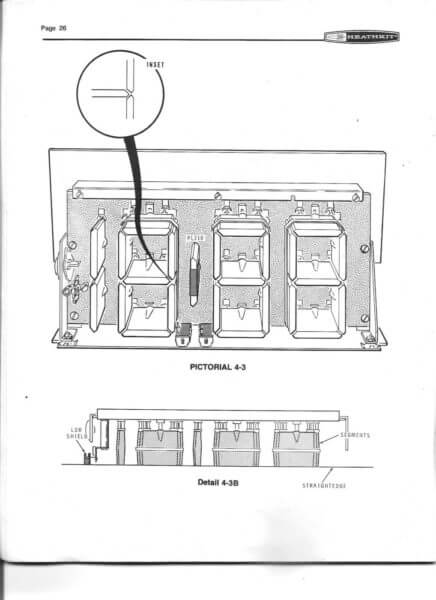
This was before bright white LED’s were available, so it used small incandescent lightbulbs with a plastic lightpipe to the front glass. Worked great, but you needed to replace the bulbs as they burned out. The suggested bulb lifetime was every two years.
I’ve got a 1981 Toshiba computer in my storeroom that takes 8 inch floppies. I’ve got ’em in a plastic looseleaf binder issued by Microsoft in 1979. I’ve also got a 1982 IBM XT with 5 inchers, once the property of Charlton Heston’s son Frazer. I had a Kaypro but foolishly plugged it in without bringing it up with a Variac. Poof! Instant Wile E. Coyote.
Very cool Phil.
Reminds me of the old explanation of how computers work: They run on smoke. When the smoke leaks out, they stop working.
“Real radios glow in the dark!”
@garymcvey, our local club does estate sales as part of our annual auction. The proceeds go to the surviving spouse. We gather and store the equipment until the next auction. Sometimes we have three or more estates (just the electronic stuff) at one auction. It often includes things like computers and similar items. One we did recently included some of the ham’s collection of beautifully – restored old radios. True working antiques. We do far better at getting reasonable prices for the widow / widower, with much less hassle. It’s a great service, and everybody wins.
well, I haven’t been on the air since 198…2? Well, don’t want to go into too many tangents here…
The smell was not specific to kits. Any new electronic device–the new receiver from Tec HiFi bought in 1979–had it.
I was actually wondering two nights ago: why was breadboard called that? Cracker board, maybe, but bread?
Quietpi, that’s wonderful. That’s true confraternity.
My original interest in building electronic things came from discovering, probably at the age of 12 or 13 the eccentric occupants of the 75 Meter amateur radio AM window. Anyway, I doubt anyone knows what I’m talking about…
I was a BXB DXer. I vaguely remember the 75 meter thing you’re talking about, and it was a fascinating story I don’t remember. Perhaps you can summarize it.
I was also interested in RTTY (“Ratty”–radio teletype) and ham TV. There are TV repeaters across the country, or were.
I keep reading that amateur radio remains vibrant, but I don’t understand how that can be when communication anywhere, for free is now mundane. Yeah. Sure, the means of communication, building and tweaking the electronics, and the antenna (putting up antennas in trees initiated with strings attached to bows and arrows or tennis balls were all well and good; and the fraternity and emergency prep were noble, but without a cool payoff–being able rob speak to Pitcairn Island or Japan–was it really worth it? Now that’s doable by cell phone or Skype, so…
To answer your question, Gary McVey, at least on the East Coast, for several decades, there has been the phenomenon of ham operators eschewing single sideband radio (which by now, may have given way to an all digital mode?( in favor of (relative) high fidelity, vacuum tube-based AM radio transmission. Along with this has gone a kind of retro-culture of long form eclectic, non-purely technical conversation. I assume it is a holdover from the 1940s and 1950’s. It still goes on. It’s mostly on 75meters; 3885khz. I’m too tired to write any more.
I was not familiar with this company and these kits, but this post has been fascinating and this observation is so true I could like it 1000 times.
God willing that there are enough kids working with modern day facsimiles – rather than leveling up on some video game – that our world can continue to have nice things.
My first working electronic project was a Heathkit distortion pedal for guitar. I found it on a shelf at a thrift store in the late ’70s – “new old stock.” I think I paid $3.00 for it which was great because I couldn’t afford the $25 or whatever for an MXR Distortion + at the local music store. I was an instant rock star when I plugged into that thing!!!
It’s called the “Maker” movement with numerous non-profit “Makerspaces” scattered around the country. There are ten or eleven of them in the Atlanta metro area alone. The trademark owners many of the boosters are typical SJWs, but the lessons learned are awfully conservative. Almost subversive, really. (-:
Example: LittleBits
I built 3 Heath computers, the H8, H89, and finally the H100, all worked well, but my first home computer was based on the Z80 microprocessor, and was sold by a small (Individual?) outfit California Computer Systems, and it supported 64K of Ram, with the option of up to an additional 448K (512K total) addressable through a 3 bit page register. If you stuck to the original 64K of Ram you could run a version of CP/M on it, but I mostly wrote small assembly language programs. It did have interfaces for two 8 inch floppy drives, that I bought from a computer parts store in Sunnyvale CA. (This was circa 1979). The most interesting thing about that system was the floppy’s. I got what I thought was a really good price at the time, and noticed that the boxes had been opened, but the floppys worked so I didn’t worry much about it then. Two years later I got a call from the Sunnyvale police, it seems the drives were stolen! I didn’t have to give them back, just provided a written statement where I bought them. Seems the store offered good prices by buying their inventory off the back of trucks. If the price is too good, it probably has something fishy about it. Documentation for that system was a parts list, and instructions like”Assemble the motherboard.” Figured out where the components went on the boards by some blurry pictures, and the part numbers on the board, and the parts list. Eventually got it at least mostly right and it ran. It didn’t come with a case, but I bought a TRS-80 case and stuffed everything into that.